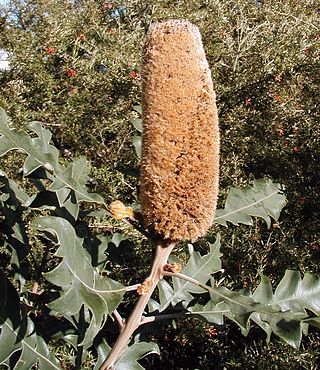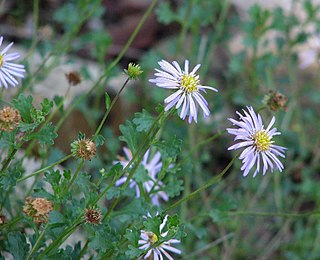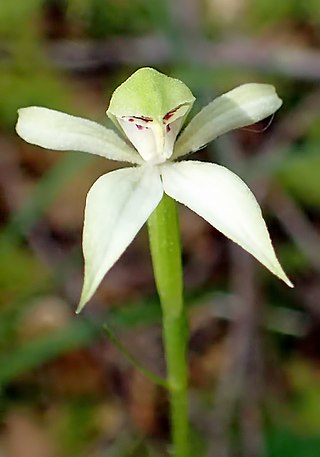
Banksia is a genus of around 170 species in the plant family Proteaceae. These Australian wildflowers and popular garden plants are easily recognised by their characteristic flower spikes, and fruiting "cones" and heads. Banksias range in size from prostrate woody shrubs to trees up to 30 metres tall. They are found in a wide variety of landscapes: sclerophyll forest, (occasionally) rainforest, shrubland, and some more arid landscapes, though not in Australia's deserts.

Root vegetables are underground plant parts eaten by humans as food. Although botany distinguishes true roots from non-roots, the term "root vegetable" is applied to all these types in agricultural and culinary usage.

Picris (oxtongues) is a genus of flowering plants in the family Asteraceae described as a genus by Linnaeus in 1753.

Ripogonum is a genus of flowering plants confined to eastern Australia, New Zealand, and New Guinea. Until recently this genus was included in the family Smilacaceae, and earlier in the family Liliaceae, but it has now been separated as its own family Ripogonaceae.

Banksia robur, commonly known as swamp banksia, or less commonly broad-leaved banksia, grows in sand or peaty sand in coastal areas from Cooktown in north Queensland to the Illawarra region on the New South Wales south coast. It is often found in areas which are seasonally inundated.

Microseris lanceolata is an Australian alpine herb with yellow flowers and one of three plants known as murnong or yam daisy along with Microseris scapigera and Microseris walteri.

Banksia solandri, commonly known as Stirling Range banksia, is a species of large shrub in the plant genus Banksia. It occurs only within the Stirling Range in southwest Western Australia. Its scientific name honours the botanist Daniel Solander, one of the first collectors of Banksia.
The murnong or yam daisy is any of the plants Microseris walteri, Microseris lanceolata and Microseris scapigera, which are an important food source for many Aboriginal peoples in southern parts of Australia. Murnong is a Woiwurrung word for the plant, used by the Wurundjeri people and possibly other clans of the Kulin nation. They are called by a variety of names in the many different Aboriginal Australian languages, and occur in many oral traditions as part of Dreamtime stories.

Microseris is a genus of plants in the tribe Cichorieae within the family Asteraceae, native to North America, Australia, and New Zealand. It contains the following species:

The National Herbarium of Victoria is one of Australia's earliest herbaria and the oldest scientific institution in Victoria. Its 1.5 million specimens of preserved plants, fungi and algae—collectively known as the State Botanical Collection of Victoria—comprise the largest herbarium collection in Australia and Oceania.

Calotis is a genus of herbs or small shrubs in the daisy family Asteraceae. Most of the species are native to Australia, while two occur in Asia.

Olearia ramulosa, commonly known as twiggy daisy-bush, is a species of flowering plant in the family Asteraceae and is endemic to south-eastern Australia. It is a shrub with narrowly elliptic, linear or narrowly egg-shaped leaves, and pale blue, mauve or white and yellow, daisy-like inflorescences.

Adenochilus, commonly known as gnome orchids is a genus of two species of flowering plants in the orchid family Orchidaceae, one endemic to New Zealand and the other to Australia. Both species have a long, horizontal, underground rhizome with a single leaf on the flowering stem and a single resupinate flower with its dorsal sepal forming a hood over the labellum and column.

The Flora Antarctica, or formally and correctly The Botany of the Antarctic Voyage of H.M. Discovery Ships Erebus and Terror in the years 1839–1843, under the Command of Captain Sir James Clark Ross, is a description of the many plants discovered on the Ross expedition, which visited islands off the coast of the Antarctic continent, with a summary of the expedition itself, written by the British botanist Joseph Dalton Hooker and published in parts between 1844 and 1859 by Reeve Brothers in London. Hooker sailed on HMS Erebus as assistant surgeon.
The Flora Novae-Zelandiae is a description of the plants discovered in New Zealand during the Ross expedition written by Joseph Dalton Hooker and published by Reeve Brothers in London between 1853 and 1855. Hooker sailed on HMS Erebus as assistant surgeon. It was the third in a series of four Floras in the Flora Antarctica, the others being the Botany of Lord Auckland's Group and Campbell's Island (1843–45), the Botany of Fuegia, the Falklands, Kerguelen's Land, Etc. (1845–1847), and the Flora Tasmaniae (1853–1859). They were "splendidly" illustrated by Walter Hood Fitch.

Olearia decurrens, commonly known as the clammy daisy bush, is a species of flowering plant in the family Asteraceae and is endemic to arid, inland Australia. It is a glabrous, sticky, twiggy shrub with narrow egg-shaped to linear leaves sometimes with toothed edges, and white and yellow, daisy-like inflorescences.

Pterostylis foliata, commonly known as the slender greenhood, is a species of orchid widespread in south-eastern Australia and New Zealand. Flowering plants have a rosette of three to six, dark green, crinkled leaves crowded around the flowering stem and a single dark green and brown flower with a deep V-shaped sinus between the lateral sepals.

Olearia pannosa, commonly known as silver-leaved daisy or velvet daisy-bush, is a species of flowering plant in the family Asteraceae and is endemic to south-eastern continental Australia. It is a spreading undershrub or shrub with egg-shaped or heart-shaped leaves, and white and yellow daisy flowers.

Microseris walteri is an Australian perennial herb with yellow flowers and edible tuberous roots, and one of three plants known as murnong or yam daisy along with Microseris scapigera and Microseris lanceolata.

Myosotis albiflora is a species of flowering plant in the family Boraginaceae, native to southern Chile and Argentina. This species was described by Joseph Banks and Daniel Solander in Joseph Dalton Hooker's 19th century work Flora Antarctica. Plants of this species of forget-me-not are perennial and have white corollas. It is one of two native species of Myosotis in southern South America, the other being M. antarctica.























